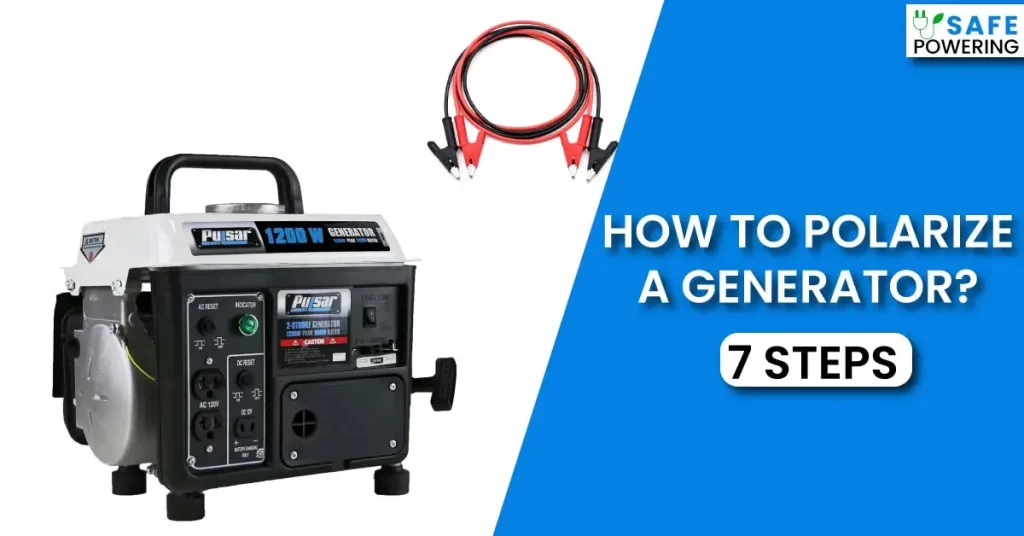How to Polarize a Generator? – [7 Steps Guide]
Save money on expensive repairs by learning how to polarize a generator with our DIY tips. Keep your power going without breaking the bank
Polarizing a generator is a critical task in maintaining the proper functioning of an electrical power system.
The process of polarizing a generator involves establishing a magnetic field within the generator’s rotor, which is necessary for the generator to produce electricity.
Without proper polarization, a generator may fail to produce electricity or may produce electricity with poor quality, leading to issues such as voltage fluctuations, power interruptions, or equipment damage.
It may seem like a daunting task, but don’t worry, it is a relatively simple process that can be accomplished with the right tools and knowledge.
Whether you are a seasoned electrician or a novice DIY enthusiast, understanding how to polarize a generator is a valuable skill that can save you time, money, and headaches in the long run.
I will try to keep the process simple so that even a non-technical guy/gal can understand it.

What is Generator Polarization?
Generator polarization is the process of restoring the residual magnetism of a generator’s field winding.
This magnetism is necessary for the generator to produce electricity, and it can dissipate if the generator is not used for an extended period.
To restore the magnetism, a small amount of current is provided to the field winding in the correct direction, usually by briefly connecting the generator to a power source such as a battery.
This process enables the generator to produce electricity once again.
How to Polarize a Generator in 7 Steps
Polarizing a generator is a process that ensures the generator is producing electricity with the correct polarity. The following steps can be used to polarize a generator:
Tools Required
- Voltage meter
- Insulated gloves
- Safety goggles
- Insulated screwdrivers
- Grounding rod
- Wrenches
STEP 1: Identify the Terminals:
After locating the generator, you need to identify the positive and negative terminals on the generator.
These are usually labeled and are often located near the voltage regulator. Knowing the location of these terminals is crucial in ensuring that you are connecting the jumper wire correctly in the next step.
STEP 2: Disconnect Loads:
Before polarizing the generator, it is important to disconnect any loads that are connected to the generator. You don’t want to be electrocuted!
This is to prevent any damage to the equipment and ensure that the generator is not producing electricity while you are working on it.
By disconnecting the loads, you can avoid any potential safety hazards and ensure that the polarizing process goes smoothly.
STEP 3: Connect a Jumper Wire:
This step involves taking a jumper wire and connecting one end to the positive terminal of the generator.
The other end of the jumper wire should be connected to the field terminal (marked “F” or “FLD”) on the voltage regulator. This will help establish the correct polarity for the generator.
The jumper wire serves as a bridge between the positive terminal of the generator and the field terminal on the voltage regulator, allowing the voltage regulator to properly regulate the voltage output of the generator.
STEP 4: Reconnect the Battery:
Once the jumper wire is connected, you can reconnect the battery to the generator.
This will provide power to the generator and allow it to start. Reconnecting the battery is crucial in allowing the generator to produce electricity and in providing power to the voltage regulator.
STEP 5: Turn ON the Generator:
After reconnecting the battery, turn on the generator and observe the voltage meter. The voltage meter should read a positive voltage.
This step allows you to confirm that the generator is producing electricity with the correct polarity.
A positive reading on the voltage meter indicates that the generator is producing electricity with the correct polarity.
STEP 6: Disconnect the Jumper Wire:
Once the generator is running, remove the jumper wire from the field terminal. This will complete the polarizing process.
Disconnecting the jumper wire is important in ensuring that the generator continues to produce electricity with the correct polarity.
STEP 7: Reconnect the loads:
Finally, you can reconnect any loads that were disconnected in step 3. Make sure to check that everything is working properly before using the equipment. This step allows you to verify that the equipment is functioning correctly after the polarizing process.
By reconnecting the loads, you can ensure that the equipment is working as intended and that the polarizing process did not cause any damage.
Negative Ground Systems and Positive Ground Systems
Before we get to the actual topic, why not learn about proper generator grounding if you want to learn more about the topic?
The terms “negative ground system” and “positive ground system” refer to the electrical polarity of a vehicle’s electrical system.
In a negative ground system, the negative terminal of the battery is connected to the chassis of the vehicle, while the positive terminal is connected to the electrical system.
In a positive ground system, the opposite is true: the positive terminal is connected to the chassis, while the negative terminal is connected to the electrical system.
Historically, positive ground systems were more common in older vehicles, while negative ground systems are more common in modern vehicles. However, there are still some older vehicles that use positive ground systems.
When it comes to polarizing a generator, the process is slightly different depending on whether you have a negative ground system or a positive ground system.
With a negative ground system, you connect the jumper wire from the field terminal to the positive battery terminal.
With a positive ground system, you connect the jumper wire from the field terminal to the negative battery terminal.
It’s important to note that if you connect the jumper wire to the wrong terminal, you can damage the generator or other electrical components.
So, it’s crucial to ensure that you know whether you have a negative ground system or a positive ground system before attempting to polarize your generator.
In summary, the terms “negative ground system” and “positive ground system” refer to the electrical polarity of a vehicle’s electrical system, and the polarity affects the process of polarizing a generator.
If you’re unsure which type of system you have or how to polarize your generator correctly, it’s always best to consult your vehicle’s owner manual or a qualified mechanic for specific instructions.
Safety Precautions before Generation Polarization
- Proper grounding: Ensure that the generator is properly grounded before polarization. This will help prevent electrical shock and reduce the risk of electrical fires.
- Safety equipment: Use appropriate safety equipment such as gloves, goggles, and insulated tools when working with the generator.
- Follow manufacturer guidelines: Follow the manufacturer’s guidelines for polarizing the generator. This will help ensure that the process is done correctly and safely.
- Disconnect power: Ensure that the generator is disconnected from power sources and turned off before beginning the polarization process.
- Use a voltage meter: Use a voltage meter to monitor the voltage during the polarization process. This will help ensure that the voltage is within safe limits and prevent damage to the generator.
- Regular maintenance: Regular maintenance like oil change, air filter cleaning/replacement, Carb cleaning, etc. ensure that the generator is in good condition and prevents issues that could lead to polarization.
Why is it Important to Polarize a Generator?
Polarizing a generator is an important process to ensure that the generator produces electrical power correctly.
When a generator is repaired or replaced, it may lose its residual magnetism, which is the magnetic field that remains in the generator even when it’s not producing electricity.
If the residual magnetism is lost, the generator won’t produce any electrical power, even if it’s mechanically sound.
Polarizing the generator restores the residual magnetism, allowing the generator to produce electricity correctly.
Connecting the jumper wire to the wrong terminal can cause a surge of electrical current that can damage the generator or other electrical components.
In addition to restoring the residual magnetism, polarizing the generator can also help diagnose issues with the generator or other electrical components.
What Happens When You Don’t Polarize a Generator?
The magnetism is stored in the pieces of pole inside the generator. This stored magnetism reminds the generator about the direction of the current.
This magnetic field is necessary to produce electrical power in the generator.
If a generator is not polarized, it may not produce any electrical output or produce a lower-than-expected output.
This is because the absence of a magnetic field in the rotor or armature can prevent the generator from generating the necessary voltage.
If a generator has lost its polarization or has not been polarized, it can be easily polarized by briefly connecting the positive and negative terminals of a DC battery to the field winding.
When to Polarize a Generator?
A generator should be polarized when it fails to produce electricity even though it is mechanically functional.
Polarizing the generator involves providing a small amount of current to the field winding in the correct direction to re-establish the magnetic field.
This process is usually necessary after the generator has been repaired or disconnected from the electrical system.
However, it is important to check the manufacturer’s instructions or consult an expert before attempting to polarize a generator, as some generators may not require polarization or may have specific procedures that need to be followed.
Is It Okay Not To Polarize A Generator?
It is generally not recommended to operate a generator without polarizing it, as the generator may fail to produce electricity even if it is mechanically functional.
Polarizing the generator is a simple process that helps to restore the residual magnetism of the generator’s field winding, which is essential for the generator to produce electricity.
Failure to polarize the generator can result in damage to the generator and other electrical equipment. Read this polarization research if you want to know more about the topic.
Final Words
Generator polarization is the process of restoring the residual magnetism of a generator’s field winding, which is essential for the generator to produce electricity.
This is typically necessary when the generator fails to produce electricity, and it can be accomplished by providing a small amount of current to the field winding in the correct direction.
It is important to follow the manufacturer’s instructions or consult an expert before attempting to polarize a generator. Failure to polarize the generator can result in damage to the generator and other electrical equipment.

Fareed, the highly skilled electrical expert, boasts 5 years of extensive experience in proficiently maintaining, repairing, diagnosing, and installing a diverse range of electrical systems.
